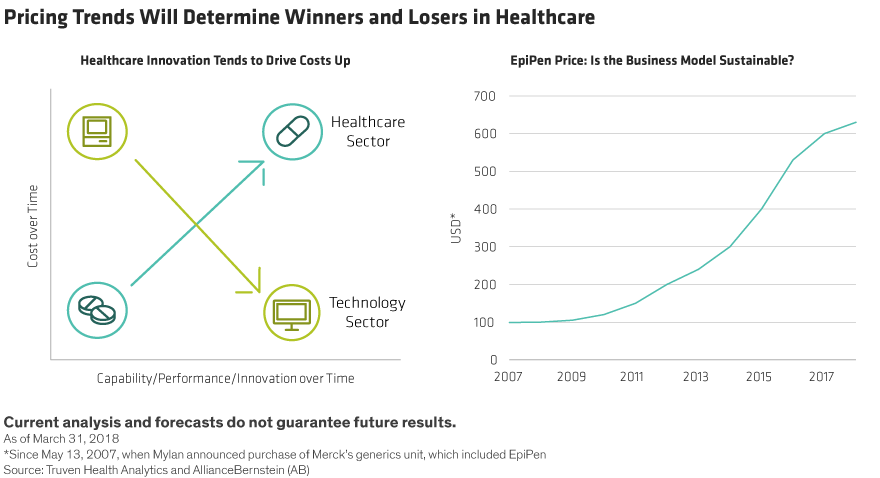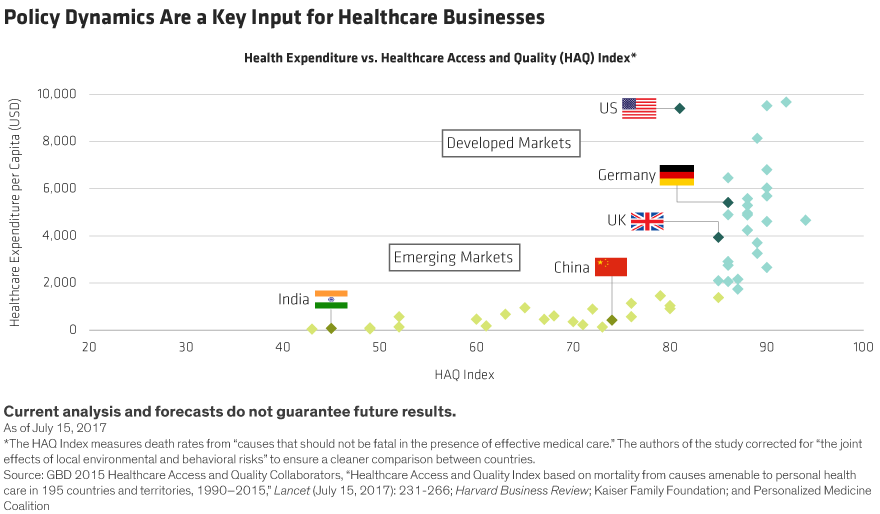Written by: Vinay Thapar
Healthcare stocks served as powerful painkillers during last year’s market declines. Yet the sector offers much more than just downside protection for investors who focus on business potential and resist the urge to predict scientific breakthroughs.While the MSCI World Index fell by 8.7% last year, healthcare stocks advanced by 4.8%. But healthcare’s reputation as a defensive haven understates the sector’s attractions. Pharmaceutical groups, medical device manufacturers and healthcare providers are benefiting from big trends that can fuel returns for investorswho are skilled at deciphering the complex forces shaping the sector.Three Big Trends
Three forces are stimulating change in healthcare today: innovation, pricing structures and policy. However, these dynamics often clash and complicate the investment outlook for a product or company. Will people pay more for a revolutionary treatment if it isn’t covered by a healthcare system? Is a government likely to provide meaningful subsidies for a new diagnostic technology? Are current prices sustainable over the long term? Questions like these vary from country to country, based on government policies, national economics, and spending or cultural preferences.Despite these challenges, we believe there are ways to make informed judgments across the industry that can lead investors to solid sources of profitability and investment returns. The first step is to avoid a common fallacy: don’t make predictions about drug trials. Even the best scientists in the world cannot reliably forecast drug-test results, so why should investors gamble? Instead, develop a clear picture of how innovation, pricing and policy dynamics could affect a company’s profitability and growth rate.Medical Innovation
Scientific innovation has underpinned healthcare advances for decades. Yet in many ways, the technological revolution in healthcare is still in its infancy. Investors need to look beyond cutting-edge equipment or biotechnology research to understand how innovation will reshape the industry. For example, although the use of big data is still relatively limited in pharmaceutical development, over time, it will probably become an integral tool in improving the efficacy of drug trials.New developments will make an impact across many areas. Robotics are already changing surgical procedures. Treatments for Alzheimer’s disease and cardiovascular disorders will help combat the physical and economic costs of demographic change. The development of solutions to age-old problems from the common cold to cancer is just a matter of time.Pricing Disruption
Still, powerful innovations don’t always make economic sense. Understanding how pricing points are determined for a new product or service is essential to gauge a company’s earnings potential.Innovation and pricing have a curious relationship in healthcare. In technology, it’s well known that innovation drives performance improvements and pushes down costs exponentially. The IBM mainframe computers that powered NASA’s Apollo spacecraft in the 1960s, which cost millions of dollars each, had a fraction of the memory and processing capacity of an iPhone. But in healthcare, the opposite happens: innovation tends to drive prices up ( Display, left). For example, 20 years ago, cancer patients paid about $200 a month for chemotherapy, and success was limited. Today, some chemotherapy treatments can cure cancer with fewer side effects, but at a cost of $100,000. In many cases, investors must ask whether prices are realistic. For example, Mylan’s EpiPen is a popular product that can avert death in cases of extreme allergic reactions. Its price has surged more than sixfold since May 2007 ( Display above, right), when Mylan bought Merck’s generic drug unit, which included the EpiPen. Is this sustainable? While high-priced products may flatter a company’s earnings and margins, they could prove to be a weakness if the price is forced down by market dynamics or policy decisions.
In many cases, investors must ask whether prices are realistic. For example, Mylan’s EpiPen is a popular product that can avert death in cases of extreme allergic reactions. Its price has surged more than sixfold since May 2007 ( Display above, right), when Mylan bought Merck’s generic drug unit, which included the EpiPen. Is this sustainable? While high-priced products may flatter a company’s earnings and margins, they could prove to be a weakness if the price is forced down by market dynamics or policy decisions.Policy Dynamics
Government policies about healthcare are a key determinant of whether a business will succeed or fail. Healthcare spending per capita differs dramatically from country to country, and the quality provided doesn’t always reflect the price paid. For example, the US spends more on healthcare than almost any country in the world, yet the quality of healthcare provided ranks lower than in the UK and Germany, which both spend much less ( Display). Policy decisions can make the difference between life and death, by determining which costs and treatments are covered. Around the world, healthcare systems are feeling the strain of rising costs, and workers are responsible for meeting more healthcare costs. At the same time, demand from emerging economies is growing, and spending is likely to increase amid efforts to upgrade the quality of healthcare. These trends will reshape price points for treatments, technology and services.Related: Why Play Defense in Rising Emerging Markets?
Policy decisions can make the difference between life and death, by determining which costs and treatments are covered. Around the world, healthcare systems are feeling the strain of rising costs, and workers are responsible for meeting more healthcare costs. At the same time, demand from emerging economies is growing, and spending is likely to increase amid efforts to upgrade the quality of healthcare. These trends will reshape price points for treatments, technology and services.Related: Why Play Defense in Rising Emerging Markets?

